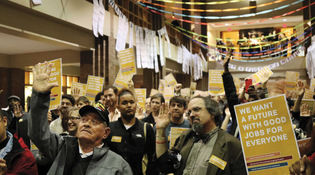 loading
loading
Light & VerityYale and unions make a dealFor the third time in a row, a contract without a strike.  Amy Cheng ’19/Yale Daily NewsUnion members and supporters held a rally at New Haven’s City Hall in November before agreeing with Yale on a new five-year contract in January. View full imageShuttered dining halls, picket lines in front of libraries, classes moved off campus: many Yale alumni remember well at least one of the seven strikes that took place from 1969 to 2003, a period Yale vice president and lead labor negotiator Mike Peel describes as “a very long and turbulent strike history—one of the worst in the American labor movement.” “I think the strikes were about dignity,” Peel says, “about not feeling respected, not feeling appreciated, often feeling like you were looked down on by faculty and managerial staff.” But in recent years, the university and its unions have gone from constant conflict to careful collaboration, and most current workers have never seen a strike. In January, members of Yale’s Local 34 and Local 35 ratified a new five-year contract, the third in a row that was negotiated without a strike. To be sure, there were some tensions in the yearlong negotiating process, some of which spilled over into city and state politics. But those tensions were of a different magnitude from past ones, and both sides say the negotiations have gone relatively smoothly, in part because of a change in the process since the 2003 strike: regular face-to-face meetings between Yale leadership and union leaders—year-round, not just during contract negotiations. “Once we had access on a regular basis with Yale decision makers, we decided to roll up our sleeves and make our case, and we became better listeners,” says Bob Proto, who has been the president of Local 35 for more than two decades and had led three of the strikes. “It takes a lot of work, a lot of problem solving. It takes a lot of trust building.” The new contract provides average yearly raises of 2.5 percent for the 3,600 clerical and technical workers of Local 34 and the 1,200 service and maintenance workers of Local 35. Local 34 also won a guarantee that 986 union positions at the School of Medicine—jobs that the union was concerned could be moved to Yale New Haven Hospital and become nonunion—would remain union jobs. Other important contract points were keeping Yale’s in-house health plan essentially free to current union members and their families while adding an emphasis on preventative care, and preserving pensions for new hires. (Although graduate teaching assistants in nine Yale academic departments are currently seeking to form a union under the auspices of UNITE HERE, the parent organization of Yale’s unions, both the university and the unions say graduate student unionization did not play a part in their negotiations.) There were some squabbles along the way in the negotiations. The unions supported a proposed state law that would have removed some of Yale’s tax exemptions, and in the fall the university and the union-dominated New Haven Board of Aldermen squared off over building permits and Yale’s voluntary payments to the city before reaching a resolution. Those hiccups aside, Peel says the university and the unions are on a path that will make the destructive conflict and repeated strikes of the past “ancient history at Yale.”
The comment period has expired.
|
|